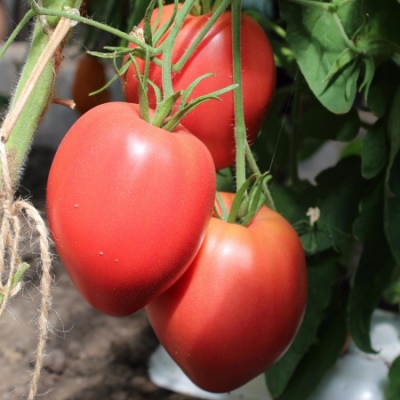
- Category: grade
- Growth type: indeterminate
- Appointment: fresh consumption, for pickling and canning, for ketchup and tomato paste
- Ripening period: mid-early
- Ripening time, days: 110
- Growing conditions: for open ground, for film greenhouses
- Bush size: tall
- Bush height, cm: more than 150
- Foliage: moderate
- Stem: strong
The King of London tomato obtained by Siberian breeders is loved by numerous summer residents for its beautiful shape and record size of fruits. The largest specimens weigh over a kilogram. The universal purpose of the fruits can also be attributed to the obvious advantages of the variety - they are suitable for processing, good in salads and fresh tomato soups.
Description of the variety
Indeterminate plants, which include the King of London tomato, have no growth restrictions. They stretch over 150 cm in height. A strong and strong stem is not standard, the bush is formed with abundant branching and a moderate leaf cover. The tops are similar to those of the potato, they are weakly colored, in a light green shade. The variety has good fruit set.
The main qualities of the fruit
Tomatoes are large, heart-shaped. The weight of each tomato varies from 800 to 1000 g. The skin is pink, dense, not thickened, but prone to cracking. The pulp is tender and fleshy. Unripe tomato is pale green, without darker spots.
Taste characteristics
The fruits have a pleasant sweetish taste with "tomato" sourness.
Ripening and fruiting
Tomato King of London - mid-early. Fruits reach ripeness 110 days after germination.
Yield
The variety is high-yielding, yields 5-10 kg of fruit per bush. Maximum performance can be achieved only on fertile soils, with proper agricultural technology.
The timing of planting seedlings and planting in the ground
Sowing the harvested material into the soil is carried out no later than 60-65 days before the planned period of moving the seedlings to the greenhouse or garden. This usually happens in the 1st or 2nd decade of March. By mid-May, you can start transplanting, having previously hardened young tomatoes for 1-2 weeks.

Growing tomato seedlings is an extremely important process, because it largely depends on whether the gardener will be able to harvest at all. All aspects must be taken into account, from seedbed preparation to planting in the ground.
Landing scheme
It is recommended to follow the planting scheme of 3 plants per 1 m2 if the bush is formed into 2 stems. This number can be increased by leaving only one central shoot. The standard distance is 50 × 70 cm with a hole depth of about 20 cm.

Growing and care
The plant is usually formed into 2-3 stems. From the very beginning, the shoot garter is used. Passynching will also have to be carried out regularly. Bush care is performed in conjunction with watering, the introduction of nutrients. The King of London needs constant hydration. Drying out the soil can negatively affect yields.
However, it is also advisable to avoid overflow. If there is too much water, the tomatoes on the branches will begin to crack, become bland and tasteless. The easiest way to solve this problem is with an automated drip irrigation system.
A useful technique for retaining moisture can be called mulching of the root zone. Both in the greenhouse and in the open field, it will provide protection from weeds, will help keep the roots from drying out in extreme heat.
Plants are transferred to open ground and a greenhouse after the appearance of 5-7 true leaves. The root system of a healthy bush should be well formed. It's not bad if it has at least 1 flower brush on it. After watering, when planting, the plants are left for 2 weeks to adapt.




A plant needs different micronutrients at each stage of growth. All fertilizers can be divided into two groups: mineral and organic. Folk remedies are often used: iodine, yeast, bird droppings, eggshells.
It is important to observe the rate and period of feeding. This also applies to folk remedies and organic fertilizers.
Disease and pest resistance
This tomato variety is not very well protected from diseases and pests. It is susceptible to late blight, but the risks of infection can be reduced if you take care of high-quality ventilation and mulching of the soil. And also the measures of prevention include artificial regulation of soil moisture.
The variety has good immunity to TMV, powdery mildew. Preventive treatments against these diseases are sufficient to carry out 2-3 times per season.


Growing regions
The King of London grows well in almost every region of the country. It was originally obtained in Siberia, where it is planted under a film. Similar methods are used in the Urals or in the Leningrad Region. In the Central Black Earth Region and Krasnodar Territory, it is possible to plant plants in open ground.
Review overview
Buyers praise the variety for its abundant fruiting, giant tomato size, bright aroma and excellent shape.The only problem is that the taste of this tomato does not always meet expectations.
But in terms of keeping quality and shelf life, the variety surpasses most of its analogues. There are no complaints about seed germination either. They hatch quite amicably, at the seedling stage they look strong. Summer residents also mention the low immunity of tomatoes. They are easily infected with cladosporium and other types of fungal diseases.

























































































